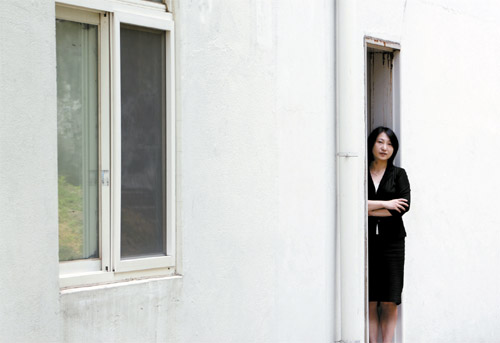Sweating with fear over a sticky summer

Baek Moon-im, a professor at Yonsei University, studies why we like a good fright at the cinema. [JoongAng Ilbo]
Freud says fear is an emotion felt when a suppressed superstition or a ghost from childhood unexpectedly reaches the body.
Turning it around, fear is one way to learn what is suppressing society. And third-rate horror films can help, although a majority of the viewers do not walk out criticizing civilization or analyzing psychology after watching blood-splattering and limb-tearing scenes.
Still, the body reacts physically when watching horror films. The heart beats faster to supply more oxygen needed when in a state of abject terror; the pupils dilate to capture more light and sight; and muscles contract to protect the body against a perceived threat. And you sweat more.
Watching a horror film also decreases the body’s sensory temperature. Energy is transferred from the skin to more essential parts of the body like the heart and brain as the body cools when the sweat dries.
That’s why people say that so many horror films are released over the hot sticky summer: They help keep you cool.
Baek Moon-im, a professor of Korean language and literature at Yonsei University, researches horror films and supports this theory.
“People are cynical when they find out that I got my Ph.D in scary movies,” Baek said. “They just mention that I have an interesting job.”
Baek understands the reaction because watching scary films is considered a “recreational activity” rather than a serious field of academic pursuit.
“After all, horrors were simply a way to cool yourself down in a period when air conditioners and trips were hard to afford,” says Baek.
But horror films are not just about keeping cool, according to Baek. They are also a means of reflecting prevailing views in society.
For example, the disturbing monsters in films can be interpreted as a reflection of social and cultural factors that people wish to destroy, Baek argues. A take on Frankenstein’s monster and Dracula is that both figures represent an escape from “bourgeois control and sexual morality blundered into anomie,” according to the academic.
A female ghost, an expected main character in Korean horror films, as depicted in Yun Jong-chan’s “Sorum” (2001), Kim Ji-woon’s “A Tale of Two Sisters” (2003) and Ahn Sang-hoon’s “Arang” (2006), also conveys a social message.
“Korean horror flicks are very different from their Hollywood equivalents where blondes get killed by a mysterious man,” Baek said.
Female ghosts in Korean horror films carry a cultural prayer and social coherence from the past, she believes.
Her research on Korean horrors was inspired by “Chunhyang,” a well-known Korean folktale.
Chunhyang is often considered a virtuous woman who scolds vain girls who yearn for freedom in love.
“Female ghosts in Korean films, however, depict the opposite. They are the exclusively possessed,” Baek said.
“They portray the struggles of wives, mothers or daughter-in-laws suppressed by a grudging Confucian society.”
Baek said Korean thrillers involve a resentful female who haunts people who wronged her in the past.
“Regardless, horror films [whether Western or Korean] will continue to prosper,” Baek said.
“Watching horrors is either thrilling like riding a roller coaster or really creepy because of the nightmares.”
Baek’s favorite is Roman Polanski’s “Rosemary’s Baby” (1968), a thriller that makes us question our close friends and families.
By Jang Jung-il JoongAng Ilbo/ Su-jeong Choi Contributing Writer [estyle@joongang.co.kr]










with the Korea JoongAng Daily
To write comments, please log in to one of the accounts.
Standards Board Policy (0/250자)